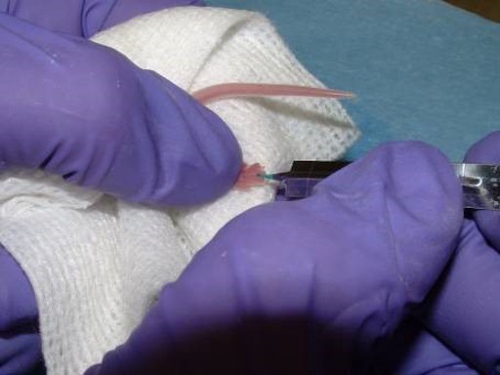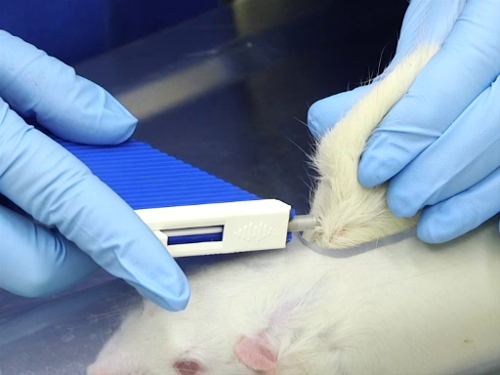1. Tatuagem de cauda
Tatuagens de cauda são facilmente lidas sem a necessidade de lidar com o animal.

Figura 1. Tatuagem de cauda em ratos adultos
- Prepare o equipamento de tatuagem de acordo com as instruções do fabricante. Uma pequena quantidade de tinta é necessária. O corante preto deve ser usado para ratos ou ratos albinos, e corante verde para ratos pigmentados ou ratos.
- Prepare os animais para identificação.
NOTA: Para minimizar a apreensão ou angústia, a tatuagem da cauda deve ser realizada em uma sala de procedimento e não em uma área de alojamento animal.
- Contenha adequadamente o animal para tatuagem para que o movimento seja mínimo.
- Ratos desmaseamento são contidos usando um copo com entalhe plástico, com o lábio do copo preso sob os parafusos na plataforma de tatuagem, e a cauda estendendo-se através do entalhe.
- Ratos adultos podem ser contidos por meio de um contidor de copo, com a cauda arrancada da abertura e a flange do copo mantida no lugar através de uma plataforma ou outro dispositivo.
- Limpe a cauda com uma pequena quantidade de limpador de tecido diluído aplicado com um cotonete de ponta de algodão. Ratos adultos geralmente têm um acúmulo de escala e detritos na cauda que devem ser limpos antes de aplicar a tatuagem. Um esfoliante de água e sabão da cauda removerá a maior parte da sujeira e detritos. Seque bem a cauda antes de prosseguir.
- Aplique óleo de tecido na pele com um cotonete de ponta de algodão pouco antes da tatuagem. O óleo de tecido é necessário para minimizar os danos teciduais, amaciando a pele e lubrificando a agulha da tatuagem. Além disso, o óleo dissolve qualquer sujeira não removida pelo processo de limpeza e evita a coloração de tinta da pele nontattooed.
- Aplique a tatuagem.
- Mergulhe a ponta da agulha no pigmento com a máquina desligada.
- Leve a ponta da agulha para o local da tatuagem com a arma ativada pelo pedal do pé.
- Faça curto, até mesmo golpes em uma direção. Numerais e letras devem ser tatuados de tal forma para que sejam construídos em segmentos com ângulos e curvas mínimos (quando possível).
- Penetre profundamente na dermis com a agulha para deposição permanente de pigmento. Uma mudança no som da agulha ativada pode ajudar a discernir a profundidade.
- Aproxime-se da pele com a agulha em um ângulo de 90o para deposição adequada do pigmento.
- Limpeza e cuidado pós-tatuagem
- Borrida (não limpe) a tatuagem completa do excesso de pigmento com uma toalha de papel.
- A presença de sangue na tatuagem ou na toalha de papel indica que a tatuagem foi feita muito profunda e, portanto, é improvável que seja permanente.
- Reforce áreas finas de personagens de tatuagem com pigmento adicional. Os caracteres são reforçados com pigmento depositado paralelamente, mas não em cima do pigmento já depositado.
- Para adicionar pigmento adicional, mergulhe a ponta da agulha no reservatório de corante para cada dois caracteres para ratos e cada caractere para ratos.
- As razões para desbotar tatuagens incluem quantidades inadequadas de pigmento, tatuagens feitas muito rasas, tatuagens feitas muito profundamente, um ângulo inapropriado da agulha para a pele, agulhas cegas ou fisadas sendo usadas, ou a tatuagem sendo feita muito rapidamente.
- Limpe completamente o equipamento de tatuagem após cada uso de acordo com as instruções do fabricante.
2. Tatuagem de dedos dos recém-nascidos
Protocolos experimentais podem exigir a genotipagem de recém-nascidos já no primeiro dia, o que torna essencial que esses filhotes sejam permanentemente identificados. O uso de tatuagem dos dedos permite que os animais sejam identificados até que sejam grandes o suficiente para marcação de ouvido ou socos na orelha.

Figura 2. A técnica de contenção adequada para tatuar um rato de nénato. A lanceta tem o corante verde na ponta.
- Contenha filhotes pré-filhotes.
- Copo o recém-nascido na mão em uma almofada de gaze. Posicione o pé entre o polegar e o torto do dedo indicador para expor o dedo do pé escolhido, ou os dedos dos pés, para a tatuagem.
- Segure o pé perto dos dedo dos pés para que o dedo tenha uma superfície sólida atrás dele, impedindo que ele se dobre.
- Não escamos a perna ao posicionar o pé. Filhotes que são contidos podem se mexer, mas nenhuma vocalização é necessariamente ouvida.
- Prepare o equipamento.
- Selecione uma lança-pedota animal Goldenrod de 4,5 mm.
- Coloque um pequeno ponto de pasta de tatuagem verde em uma superfície não porosa; a folha de alumínio funciona bem.
- Mergulhe apenas a ponta da lanceta na pasta da tatuagem.
- Use apenas uma pequena quantidade de pasta.
- Aplique a tatuagem.
- Cutuque o dedo desejado com a goldenrod lancet de acordo com um código de identificação.
- Fure a pele para introduzir a pasta na pele, deixando uma marca.
- Cutuque o mesmo local três vezes para garantir a penetração adequada.
- Evite cutucar tão profundamente que o dedo do dedo sangra; isso pode resultar em uma tatuagem mais fraca.
- Limpeza e cuidado pós-tatuagem
- Limpe suavemente o local com uma limpeza absorvente/toalha para remover o excesso de pasta.
- Não tente limpar o excesso de pasta do pé ou do corpo.
- Devolva o animal para sua gaiola.
- Quando os filhotes de enfermagem são tatuados, é aconselhável também tatuar a represa. Isso pode impedi-la de exagerar na pasta dos filhotes, o que pode levar ao uso excessivo da tatuagem.
- Use uma lança lança-lança para cada ninhada.
- As tatuagens devem ser verificadas no dia seguinte ao procedimento. Refaça a tatuagem se os pontos estiverem fracos ou não visíveis. Se os pontos forem visíveis no dia seguinte à tatuagem, eles devem permanecer visíveis durante a vida do animal.
3. Tatuagem dos dedo do dedo de ratos e ratos adultos
Quando uma ninhada de recém-nascidos é tatuada, sugere-se que a mãe também seja tatuada para que a pasta em seus filhotes não seja estranha a ela.
- Contenção do animal.
- Contenha o animal usando um cone de plástico ou um conterrmetro plexiglass que permite o acesso aos pés traseiros.
- Estenda o pé do dispositivo de contenção.
- Posicione o pé entre o polegar e o torto do dedo indicador para expor o dedo do pé escolhido, ou os dedos dos pés, para a tatuagem
- Segure o pé perto dos dedo dos pés para que o dedo tenha uma superfície sólida atrás dele, impedindo que o dedo do pé se dobre.
- Não escamos a perna ao posicionar o pé. Adultos que são contidos podem tentar retirar o pé.
- Prepare o equipamento.
- Selecione uma lança-pedota animal Goldenrod de 5 mm.
- Coloque um pequeno ponto de pasta de tatuagem verde em uma superfície não porosa; a folha de alumínio funciona bem.
- Mergulhe apenas a ponta da lanceta na pasta da tatuagem.
- Use apenas uma pequena quantidade de pasta.
- Aplique a tatuagem.
- Cutuque o dedo desejado com a goldenrod lancet de acordo com um código de identificação.
- Fure a pele para introduzir a pasta na pele, deixando uma marca.
- Cutuque o mesmo local três vezes para garantir a penetração adequada.
- Evite cutucar tão profundamente que o dedo do dedo sangra; isso pode resultar em uma tatuagem mais fraca.
- Limpeza e cuidado pós-tatuagem
- Limpe suavemente o local em uma limpeza absorvente/toalha para remover o excesso de pasta.
- Não tente limpar o excesso de pasta do pé ou do corpo.
- Devolva o animal para sua gaiola.
- Use uma lança lança para cada animal.
- As tatuagens devem ser verificadas no dia seguinte ao procedimento. Refaça a tatuagem se os pontos estiverem fracos ou não visíveis. Se os pontos forem visíveis no dia seguinte à tatuagem, eles devem permanecer visíveis durante a vida do animal.
4. Microchipagem
A implantação de um chip RFID é um método comumente utilizado para identificar animais.
- Carregue o microchip no aplicador ou selecione uma seringa pré-carregada.
- Contenha o animal usando um tubo de contenção plexiglass que permite a apreensão da pele sobre os ombros.
- Tenda a pele, criando um bolso.
- Coloque a agulha através da pele, bisbida para cima e paralelamente à coluna vertebral, e direcionou-a para a cauda.
- Ejete o microchip subcutânea.
- Retire a agulha e belisque a pele fechada no ponto de injeção. Isso impede que o microchip siga a agulha para fora da pele. Continue a pressionar para fornecer hemostasia para qualquer sangramento na pele.
- Remova o animal do dispositivo de contenção e escaneie o chip para confirmar o código de identificação.

Figura 3. Colocação de microchip em ratos adultos.
5. Identificação temporária para camundongos
Corantes não ttóxicos e marcadores animais podem ser usados para identificação temporária de camundongos.
- Contenha o mouse de tal forma que a área entre a escápula seja acessível para marcas na pele.
- Coloque um marcador, ponto ou raia de corante na pele nesta área. Esta região é usada para evitar que o animal remova a marcação durante o preparo.
- Verifique a marcação periodicamente se usá-la como único identificador por mais de alguns dias.
- A cauda também pode ser usada por curtas durações. No entanto, o animal pode remover uma marca dele durante o preparo.
6. Identificação temporária para ratos
- Contenha o rato para que a área para aplicação de corante ou marcador seja facilmente acessível. Em alguns casos, quando apenas uma listra ou ponto é necessário, o animal não precisará ser contido, mas é permitido se mover livremente na gaiola.
- A contenção manual, agarrando a cauda e segurando-a esticada durante a aplicação da identificação, é comumente feita.
- A imobilização temporária usando anestésicos inalatórios pode ser feita para animais fractious.
- Verifique a marcação periodicamente se usar este método como o único identificador por mais de alguns dias.

















